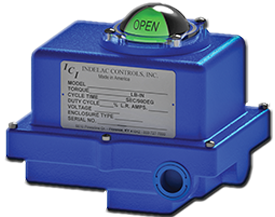
Actuators can have many different sizes, shapes and functions, but all of them require some sort of input power to move the valve or the damper they are mounted on. On this blog, we have talked about many different input sources in the past, from compressed air for pneumatic actuators to electricity for electric actuators but rarely about the first source ever used: manual input. Nowadays this source of power is not as used as before but it can still be a viable option in some specific situations.
Before digging into the article, a quick clarification has to be done: the “actuator” is the device and the “operator” is the human using it. As a manufacturer of actuators, here at Indelac, we sometime encounter customers having some confusion between these 2 terms.
Learn more about electric actuators here.
When to use a manual actuator?
When defining situations where manual actuators are useful, there are several factors to take into account. The first and most important one is price. When having the absolute lowest purchasing price as #1 driver, no other alternative can compete.
Manual actuators utilize levers, gears, or wheels to enable movement of the damper or valve while a power actuator has an external input to deliver the force and motion to operate the valve or damper remotely or even automatically. Automatic actuators are a requirement on valves or dampers located in remote locations. They are also used to automate devices that are activated frequently or used in modulating applications. Also dampers and valves that are very large may not be possible or practical to operate manually purely because of the total horsepower required.
Moreover, some devices may be placed in hazardous environments that prevent manual operation. Additionally, as a safety feature, some power actuators may be required to function very quickly, for instance shutting down a process in case of emergency.
To sum up, if the access to the device is unrestricted, the valve or damper quantity is reasonably low, operator input requirements are reasonable, and when use is infrequent, the environment safe, and also the operating speed is not critical, then the choice of manual actuation is definitely coherent. And obviously, if any of the above are not applicable, manual actuation would be inappropriate.
Different kinds of manual actuators
Currently, the manual actuator market is divided into 3 categories: devices with handles, with hand wheel or chain wheel.
Actuators with handles
It exists many types of handle equipping manual actuators in the actuation industry:
- Plain
- Latching
- Locking
- Reversible
- Wrench
- Spring Return…


Actuator with hand wheel
 As well as for the handles, there are various kinds of manual actuators with hand wheel. Among the most commonly used are:
As well as for the handles, there are various kinds of manual actuators with hand wheel. Among the most commonly used are:
- Self-locking hand wheels
- Declutchable gear boxes
- Gear boxes with hand wheel
- Gear boxes with spur/worm gear and hand wheel
Actuator with chain wheel
 Finally, when manual gear box actuator is a suitable solution but situated in a place out of the operator’s reach, a chain wheel can replace the hand wheel and allowing the device to be operated from below.
Finally, when manual gear box actuator is a suitable solution but situated in a place out of the operator’s reach, a chain wheel can replace the hand wheel and allowing the device to be operated from below.
While designs integrate features to prevent the chain to be stuck or get out of the rail, regular maintenance is mandatory to guarantee safe operation. Besides, when considering this device, know that the input force will be limited to the operator’s weight.







